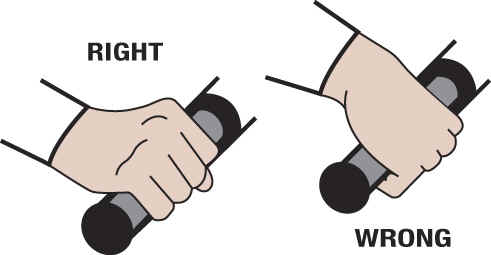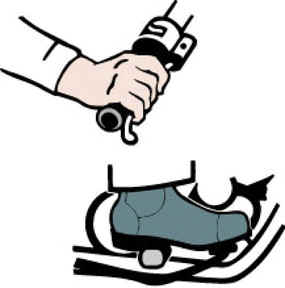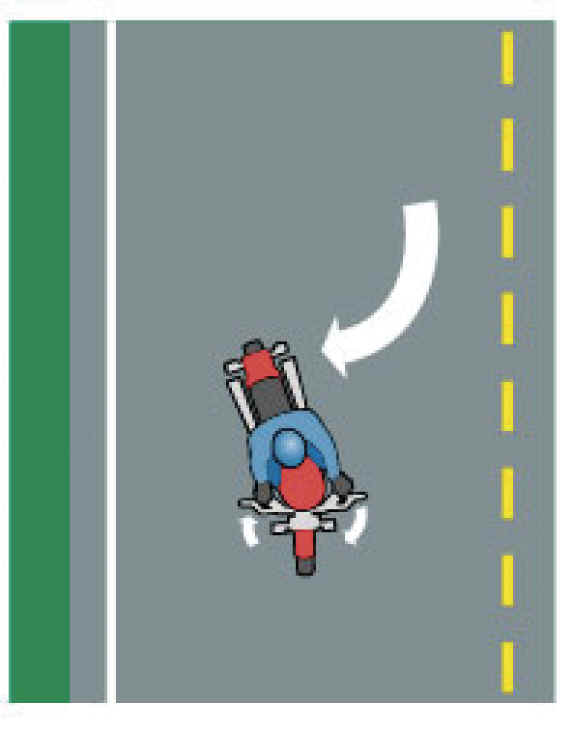A motorcycle is a unique vehicle. It requires both skill and a proper attitude from the rider if it is to be ridden safely. Each motorcycle is different and will respond differently to rider inputs.
Practice proper motorcycle techniques, including slow speed skills, countersteering, braking and swerving in a safe place.
Position of the Rider
Hands - start with your right wrist as close to flat as possible. Hold the handle grips lightly but firmly. Use a hand grip that will prevent you from accidentally using too much throttle, but allows you access to all the controls. Choose a grip for your motorcycle and physical size.

Balance - to help keep your balance, hold your knees with a light contact against the gas tank and look in the direction you want to go. Do not look down.
Feet - should be firmly on the foot pegs immediately beside the brake and shift lever at all times when the motorcycle is moving. Do not point your feet down. If they drop down, they may get caught between the road and the foot pegs. You need your feet for effective braking and gear selection. Do not drag your feet or rest them on the controls.
Starting
It is best for beginners to practice starts and stops in a safe, traffic-free area. Smooth coordination is required between the clutch and the throttle. Too much throttle can cause a rider to lose control, too little will cause the engine to stall.
Before starting out check the following:
- If the motorcycle is equipped with an anti-theft lock be sure it is released allowing the handle bars to move freely from left to right.
- The mirrors are adjusted properly.
- The fuel is turned on.
- The engine cut-off switch is set to the run position.
- The engine is warmed up and running smoothly.
- The lights are on.
Take the bike off the stand before allowing a passenger to get on. Always check that your footing is secure so that you do not loose your balance before taking the bike off the stand.
Make sure the path in front is clear of:
- children
- pedestrians
- other traffic
- any obstacles.
Before pulling away, make sure it is safe:
- Look over both shoulders to check the blind spots.
- Make sure other road users see you. Many drivers have trouble seeing motorcycles and may drive in front of them. Most drivers involved in a collision with a motorcycle say they never saw the motorcycle. Use your signals and yield to other traffic when entering the traffic flow.
Manual (standard) transmissions
Shifting gears on a motorcycle equipped with a manual transmission is a skill that requires considerable practice. The rider must learn to change gears using the left foot to operate the gearshift lever and the left hand to operate the clutch.
The engine provides power. The clutch is used to transfer power, or separate power, from the engine to the rear wheel. When the clutch lever is released, the connection is engaged and the power of the engine is transferred to the drive wheel of the motorcycle.
When the clutch lever is squeezed, the connection is disengaged. This prevents the transfer of engine power to the drive wheel. It is while the connection is disengaged that the rider changes gears.
As the rider begins to release the clutch lever, the connection will begin to engage again. This can be felt before the clutch lever is fully released. The point where this first occurs is called the “friction zone.”
It is in this friction zone that the rider must coordinate the slow release of the clutch lever while gently using the throttle to achieve a smooth start and prevent engine stalling.
When riding, it is important that the proper gear is selected so the engine does not lug (move the vehicle in rough, bumpy fashion) or race (revs the engine but does not move the motorcycle effectively). Once the motorcycle is in motion and the rider has completed shifting to the selected gear, the hand must be removed from the clutch lever and returned to the hand grip.
Shifting gears
Smooth and timely gear shifting takes practice but, once learned, will help you maintain control. The owner’s manual will explain the number of gears and the optimum speed for each gear. Start out in first gear and gradually shift up to higher gears as the speed increases. Try to maintain a speed that is appropriate for the conditions. Remember that the posted speed limit is the maximum for ideal road and weather conditions.
Remember to always be in the correct gear for the speed at which you are travelling. You should also be in a gear that will make it possible to accelerate away from any hazard.
There is more to shifting gears than simply getting the motorcycle to accelerate smoothly.
Shifting to a higher gear (up shifting) Accelerate in first gear.
- Turn the throttle off while squeezing the clutch lever.
- Place your foot under the gear change lever and move it upwards to select the second gear.
- Slowly release the clutch and gently apply the throttle.
- A smooth shift to the next gear is the result of a coordinated clutch release with the application of a small amount of throttle.
Downshifting one or more gears
- Turn the throttle off while squeezing the clutch lever.
- Place your foot on top of the gear change lever. Firmly push the lever down as far as it will go and then release.
- Slowly release the clutch and gently apply the throttle.
It is important to shift down through each gear when slowing down or stopping. However, it is possible to come to a complete stop without releasing the clutch and shifting down to first gear.
Make sure the motorcycle is going slowly enough when shifting to a lower gear. If the motorcycle is going too fast, it will lurch and the rear wheel may lock. This is more likely to happen under adverse road and weather conditions such as rain and loose gravel. Under these conditions you may need to slow down enough to shift safely. Be aware that any sudden deceleration by downshifting without braking can surprise the motorist behind. This is because your taillight will not light to give warning.
Turning corners
It is best to shift gears before entering a turn. The entry speed of a turn should be a speed where you can gently accelerate through the turn. Any sudden change in power to the rear wheel can affect balance and exceed the amount of traction available. This can cause the wheel to lock, spin or create a skid.
Starting on an uphill grade
It is more difficult to get a motorcycle moving on an uphill grade than it is on flat ground. There is a greater danger of rolling backward into someone or stalling the engine. Here is the best way to do it.
With the engine running, use the front brake to hold the motorcycle and shift into first gear.
Change to the foot brake to hold the motorcycle while opening the throttle slightly with your right hand.
Slowly release the clutch until reaching the friction zone then release the rear brake while gradually applying more power with the throttle. Avoid releasing the clutch too quickly since it may cause the engine to stall, or cause the front wheel to come off the road resulting in a loss of control.
Traction
Traction is the amount of grip between your tires and the road surface. Loss of traction can have disastrous results for the rider of a two-wheeled vehicle. Some of the most important factors affecting the amount of traction available are:
- tire compounds – softer compounds provide greater traction at the expense of a shorter tire life
- tire pressure – maintain pressure according to the manufacturer’s specifications
- tire tread patterns – select tires that are appropriate for the conditions you expect to encounter
- road surfaces – asphalt (wet or dry), concrete (wet or dry), metal, snow and ice, gravel, sand, painted lines, various types of road debris such as antifreeze, oil, leaves, holes, frost cracks and spilled materials.
Be aware that roads are most slippery during the first few minutes of rain. The motorcyclist should scan the road surface ahead to determine road condition. Braking, cornering and acceleration require the most traction. The rider’s demand for traction will determine how the traction is used. A rider should always be aware that there is only a certain amount of traction available. If the demand exceeds the traction available, the result will be a loss of control.
Braking and Stopping
A majority of motorcycles have two brakes which operate independently. In most cases, there is the hand-operated front brake and the foot-operated rear brake. When stopping, apply both front and rear brakes at the same time. The front brake provides about 70 percent of a bike?s braking power. It is best to apply the brakes by gradually increasing pressure. This progressive braking makes it possible to control the amount of braking force needed to achieve threshold braking.

Some motorcycles are equipped with integrated braking systems that link front and rear brake operation together. Anti-lock brake systems are also available on some models. If your bike has either of these systems, check your owner?s manual for instruction on the best way to use the brakes.
Some braking tips
- Make a smooth downshift to avoid a rear wheel skid. Downshifting when braking will allow you to use engine compression to help the motorcycle to slow down, but it will not activate the brake light. This will mean that motorists behind you will not be warned that you are braking.
- Use extra caution when braking in a turn, and on slippery or rough roads. When possible, avoid braking and turning at the same time.
- Practice controlled stops in a safe, traffic-free area.
- Learn to apply even braking force and acquire a feeling for when your tires are about to skid. This is called threshold braking.
- You can apply both brakes in a curve after straightening the motorcycle. When doing this, use caution and take care not to lock either wheel, especially on slippery road surfaces.
- Shift to first gear while stopping so you can move forward quickly if necessary.
- Keep at least one brake firmly applied while stopped.
- Riding with your brake partially applied activates the brake light. This may confuse other drivers, and cause unnecessary wear on the brakes.
- When applying brakes in an emergency, use both brakes to the maximum effort but do not lock the wheels. Over-braking one or both wheels is one of the most common causes of skidding.
- If the front wheel locks, release the brake immediately. If the rear wheel locks when travelling in a straight line, it is safe to slowly release the brake. If the bike is not travelling in a straight line, then it is best to keep the rear brake applied until stopped.
- If the skid is caused by over-acceleration, ease up on the throttle and steer in the direction you want the front of the bike to go.
Stopping distance
Not all riders know how much time or distance it takes to fully stop a motorcycle. As a result, they may make errors in judgement that can lead to a collision. Three factors determine how long it takes to stop. These factors are perception time, reaction time, and braking time.
1. Perception time
Perception time is how long it takes for your brain to recognize a situation and understand the need to stop. This can take about three-quarters of a second, depending on the rider. Less experienced riders are often slower to recognize a danger. The time this takes vary greatly depending on the rider’s visual search skills, level of attention, decision making abilities, degree of fatigue, and use of alcohol or other drugs. Perception distance is how far a motorcycle travels during this time.
2. Reaction time
Reaction time is the time it takes to physically react and to start braking. The average reaction time is three-quarters of a second. Reaction distance is how far a motorcycle travels during this time.
3. Braking time
Braking time is how long it takes a motorcycle to stop, from the time the brake is first applied until the motorcycle actually stops. The distance travelled in this time is called the braking distance. The actual braking distance will depend on the speed, weight of the motorcycle, traction of the tires on the road surface, the quality of the brakes, road and weather conditions and rider skill.
Total stopping distance is the sum of perception distance, reaction distance and braking distance.
Remember, when you increase your speed, you increase your stopping distance.
Skids
Skids are the result of:
- rider input as to how a rider uses the throttle, clutch, brakes and handles road conditions
- turning too sharply or at too great a speed
- braking too hard, usually the rear wheel
- accelerating too quickly
- the combined effects of braking and turning on the amount of available traction.

These rider errors are made even worse by poor road conditions, such as slippery surfaces or loose sand or gravel. The best way out of a skid is not to get into one. Plan ahead so you will not be forced to make rapid adjustments. When you are not familiar with the road, drive slower. If a skid occurs, don't panic. If handled properly you may be able to get out of difficulty.
MORE to come, tired of uploading... (",)
No comments:
Post a Comment